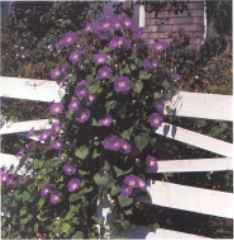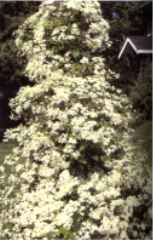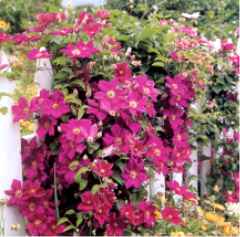 |
 |
 |
|
|
Fall Flowering Clematis |
|
|
|
 |
 |
 |
|
|
Fall Flowering Clematis |
|
Clematis is one of the most popular vines used in the landscape. In addition to serving as a vertical backdrop often called for in landscaping, Clematis flowers profusely and the fall flowering vine provides an intense, sweet fragrance. Today I will discuss pronunciation of "Clematis", culture, and pruning.
The generally accepted pronunciation of Clematis is "CLEM a tis". The other pronunciation is "cle MA tis". You say "tomAto", I say "tomAUto". Those who say "cle MA tis" are almost always corrected by those who say "CLE ma tis", but you will never hear a correction from the user of "cle MA tis". In the horticulture world, "CLEM a tis" is considered correct, but I suggest you pronounce this term as you wish. The beauty is in the flower, not the name.
Clematis is a sun loving plant which is generally available in a rooted form or potted, though it is derived from seed.* Clematis should be planted from bulb in the spring and will have little or no flowering in the first season, as is the nature of many perennials. In the second and following years, jump back! They like sunny tops, but cool roots. Normally we would pile mulch around a plant to keep roots cool, but a clematis can develop stem rot if mulch is applied against its base. We recommend the use of smaller perennials for root shade, or stone as a mulch since it provides great drainage. You can use a couple of inches of mulch, but stay clear of the stem. Clematis prefers to be kept evenly moist in a typical well drained, rich garden soil. Clematis has moderate fertilization needs and should be feed with a general purpose fertilizer in April and early August. The time frame for blooming ranges from May through September for many varieties. Most clematis will experience powdery mildew if they receive too much shade.
Proper pruning will depend on the variety of clematis you have obtained, so variety names are important. There are basically two categories of pruning needs. One is clematis which offers its first flowering from last season's growth and this group tends to bloom early in the spring. The other group blooms later and on new growth.
The "last season growth bloomers" will produce swollen buds along their stems. When this swelling occurs, you should do your pruning to eliminate any dead or diseased material and your shaping should take place at this point. If you prune late in the season or in early season, you will trim out potential blooms for the year. A few of the popular varieties in this group include the blue "Belle Of Woking", the red "Carnaby", the white "Henryi", and the pink "Nelly Moser". All of these plants tend to bloom 3 or 4 times from May through September.
The "new growth (current season's growth) bloomers" should be pruned in February or March to remove dead or diseased material. This pruning can be much more drastic than that of the "last season bloomer" since these plants bloom on the season's new growth. A couple of popular varieties in this group the red "Ernest Markham", and the deep purple (and most popular clematis) "Jackmanii". These plants tend to bloom 2 or 3 times from June / July through September.
Clematis montana is a species clematis commonly found in pink and white. This plant blooms strictly on old wood, so pruning has to be done immediately following bloom. Their shorter bloom season is in May / June, but they are vigorous and massive. They also have nice fragrance.
The Queen of Clematis is the Clematis terniflora (also known as C. paniculata or C. maximowicziana) is the fall flowering or "Sweet Autumn Clematis". The correct name is Clematis terniflora.* This massive vine waits until August / September to throw out innumerable small white blossoms which have a very sweet fragrance which brings joy to the season. The vine is very sturdy and mailbox posts have been literally lost in this plant. I caution that it can also be somewhat invasive, showing up most anywhere a bird might drop its seed. The Sweet Autumn blooms on old wood and should be shaped after its bloom season, though you might want to take a whack at it in spring simply for the purpose on constraint. This plant has a fairly good shade tolerance as well.
*Denotes corrections made due to the kind comments of a reader. This is how we all learn.
Andy Lynn